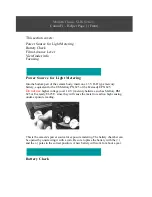
Any wet surfaces, e.g. as a result of surface condensation, have a definite effect on
heat transfer at the surface and the surface temperature. Where there is moisture on
a surface, there is usually some evaporation which draws off heat, thus lowering the
temperature of the surface by several degrees. There is risk of surface condensation
at major thermal bridges and insulation defects.
Significant disruptions of the kind described here can normally be detected and
eliminated before measuring.
If during thermography it is not possible to shield surfaces being measured from
disruptive factors, these must be taken into account when interpreting and evaluating
the results. The conditions in which the thermography was carried out should be
recorded in detail when each measurement is taken.
16.3.4
Surface temperature and air leaks
Defects in building airtightness due to small gaps in the structure can be detected
by measuring the surface temperature. If there is a negative pressure in the building
under investigation, air flows into the space through leaks in the building. Cold air
flowing in through small gaps in a wall usually lowers the temperature in adjacent
areas of the wall. The result is that a cooled surface area with a characteristic shape
develops on the inside surface of the wall. Thermography can be used to detect
cooled surface areas. Air movements at the wall surface can be measured using an
air velocity indicator. If there is a positive pressure inside the building being investi-
gated, warm room air will leak out through gaps in the wall, resulting in locally warm
surface areas around the locations of the leaks.
The amount of leakage depends partly on gaps and partly on the differential pressure
across the structure.
16.3.4.1
Pressure conditions in a building
The most important causes of differential pressure across a structural element in a
building are
■
wind conditions around the building;
■
the effects of the ventilation system;
■
temperature differences between air inside and outside (thermal differential pres-
sure).
The actual pressure conditions inside a building are usually caused by a combination
of these factors.
The resultant pressure gradient across the various structural elements can be illustrated
by the figure on page 78. The irregular effects of wind on a building means that in
practice the pressure conditions may be relatively variable and complicated.
76
Publ. No. T559382 Rev. a358 – ENGLISH (EN) – June 23, 2009
16 – Introduction to building thermography
Summary of Contents for Extech i5
Page 2: ......
Page 3: ...User s manual Publ No T559382 Rev a358 ENGLISH EN June 23 2009 ...
Page 6: ...vi Publ No T559382 Rev a358 ENGLISH EN June 23 2009 ...
Page 179: ......
















































